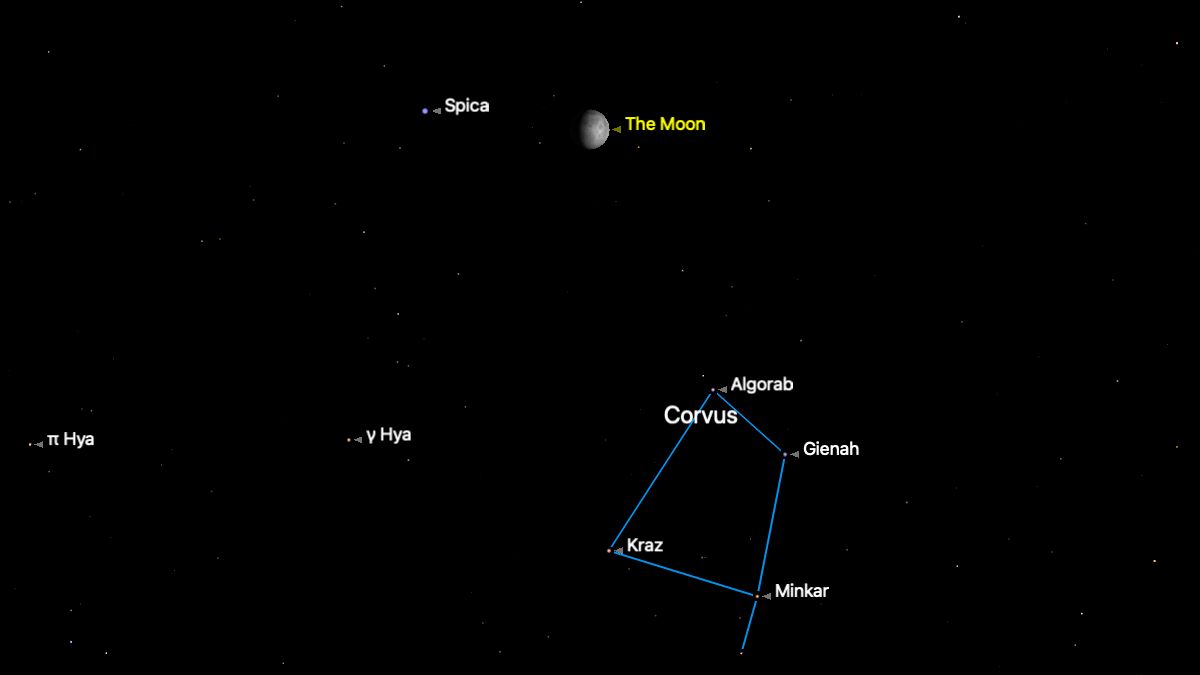
Should your local weather forecast suggest that Thursday evening (March 23) will be fair and clear it will be well worth making a mental note to be outside about an hour after the sun goes down. If you head outside at that early evening hour and if you have a clear and unobstructed view toward the west, you will be treated to a lovely pairing off of the two brightest objects in the night sky.
You'll immediately notice the crescent moon; appearing as a slender sliver, its disk will be illuminated just 6% by sunlight. And hovering well above and slightly to the left of the lunar crescent will be the planet, Venus, shining like a brilliant silvery-white celestial lantern of magnitude -4.0.
The two objects will be separated by roughly 6.5 degrees, which is roughly equal to two-thirds of the apparent width of your fist held at arm's length. This won't be an exceptionally close approach between these two objects but their great brilliance makes them an eye-catching sight in the early morning sky.
Related: Night sky, March 2023: What you can see tonight [maps]
The following evening (Friday, March 24), it will appear that they will have switched positions. On that night, a slightly wider (12%) lunar crescent will be hovering well above and slightly to the left of Venus.
Of course, what we'll see is an illusion of perspective. The moon is 233,400 miles (375,700 km) from Earth, while Venus is 492 times more distant at 115 million miles (185 million km) away. Venus is becoming increasingly prominent as it slowly gets higher in our western evening sky with each passing night. Right now, it's setting around 10:15 p.m. local daylight time. But two months from now, Venus will be noticeably higher in the west-northwest sky about an hour after sunset, and not setting until close to midnight.
Venus shines like a beacon through the fading dusk; the first planet to look for when the sun goes down. At sunset, face west and look about one-third up from the horizon to the point directly overhead — about 32 degrees above the western horizon — to find Venus. Your clenched fist held at arm's length is roughly 10 degrees wide. So — the equivalent of roughly three clenched fists up from the horizon — will take you to Venus.
Get the Space.com Newsletter
Breaking space news, the latest updates on rocket launches, skywatching events and more!
Remember that the moon will appear almost directly below it on March 23 and almost directly above it on March 24. Later in twilight Venus becomes plainly visible. In a telescope, Venus' disk is dazzling, yet unimpressive. It's still relatively small and 80 percent illuminated — a gibbous (less full) phase.
And lastly, if clouds obscure your view of Venus and the Moon on either Thursday or Friday evening, don't fret. Your next opportunity to see them together again will come on Sunday, April 23.
If you're looking for a telescope or binoculars to observe the night sky, our guides for the best binoculars deals and the best telescope deals now can help. Our best cameras for astrophotography and best lenses for astrophotography can also help you prepare to capture the next skywatching sight on your own.
Fancy taking a more in-depth moonlit tour of our rocky companion? Our ultimate guide to observing the moon will help you plan your next skywatching venture whether it be exploring the lunar seas, mountainous terrain, or the many craters that blanket the landscape. You can also see where astronauts, rovers and landers have ventured with our Apollo landing sites observing guide.
Editor's Note: If you snap a photo of the moon and Venus and would like to share it with Space.com's readers, send your photo(s), comments, and your name and location to spacephotos@space.com.
Joe Rao serves as an instructor and guest lecturer at New York's Hayden Planetarium. He writes about astronomy for Natural History magazine, the Farmers' Almanac and other publications. Follow us on Twitter @Spacedotcom and on Facebook.
Join our Space Forums to keep talking space on the latest missions, night sky and more! And if you have a news tip, correction or comment, let us know at: community@space.com.

Joe Rao is Space.com's skywatching columnist, as well as a veteran meteorologist and eclipse chaser who also serves as an instructor and guest lecturer at New York's Hayden Planetarium. He writes about astronomy for Natural History magazine, Sky & Telescope and other publications. Joe is an 8-time Emmy-nominated meteorologist who served the Putnam Valley region of New York for over 21 years. You can find him on Twitter and YouTube tracking lunar and solar eclipses, meteor showers and more. To find out Joe's latest project, visit him on Twitter.
